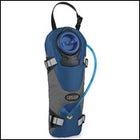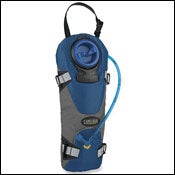Sometimes the Gear Guy is completely taken aback by a question. This is one of those times. If I understand you correctly, the problem is that you cant gauge when the bladder is nearing empty. Correct? But your friends with bottles know when their bottles are empty. Correct as well?
CamelBak UnBottle 100
 UnBottle 100
UnBottle 100Well, no one makes a gauge that tells” you when the bladder is empty. You fill it, you drink, and when you drink enough, it runs dry. If you ran out before your friends, that may be a good thing. It means you were drinking more (assuming you all started with equal amounts), thus staying more hydrated. It may also mean you are constantly sipping when you dont really need to.
So, heres a solution: Switch to a bottle.
I like hydration packs, and I use them especially for long mountain-bike treks when bottles are impractical. But how we became convinced we all need $100 canteens is a little beyond me. I still tend to adhere to regular bottles when hiking/backpacking, for the following reasons:
Easy to clean.
Easy to fill.
Sociableyou hike for an hour, find a shady spot, and everyone pulls out their bottles to have a drink and a chat.
Easy to tell when empty.
Can carry the king of juices, pineapple-orange-banana juice (try putting THAT in a hydration bladder, then cleaning it out).
Cheap!
Plus, I agree with your point about storing them in a pack. It can be a headache to pull out an empty bladder, and then wiggle a full one back in. Thats even the case in packs with dedicated slots. Another solution: Get a UnBottle 100 ($35) and use its tie-down points to lash it to the outside of the pack.
Sometimes, simpler really is better.
The 2008 Summer ���ϳԹ��� Buyers Guide is now online. From riding to trail-running to camping, get reviews of nearly 400 gear must-haves.


